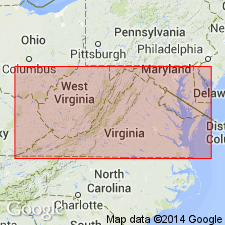
- Usage in publication:
-
- Chesapeake formation
- Modifications:
-
- Named
- Dominant lithology:
-
- Clay
- Sand
- Marl
- AAPG geologic province:
-
- Atlantic Coast basin
Summary:
Named for Chesapeake Bay, a large estuary flowing through MD and VA. Name applied to Miocene [marine] deposits of eastern VA and MD which are well developed in areas adjacent to Bay. Basal part consists of dark clay and fine, marly sand containing extensive and well-known diatomaceous deposits. These are overlain by lighter clays and sands with basal inclusions of blue marl. Upper part is coarser grained and consists of white beach sands containing shells, deposits of shell fragments, and argillaceous members. All three parts intergrade in zones and thicken seaward; thickness of 1000 ft for entire formation found at Fort Monroe. May be separated faunally into Marylandian and Virginian (as proposed by Heilprin); faunal change is transitional. Unconformably underlies Appomatox formation; unconformably overlies Eocene Pamunkey formation.
Source: GNU records (USGS DDS-6; Reston GNULEX).
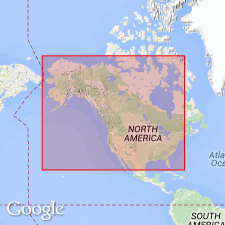
- Usage in publication:
-
- Chesapeake group*
- Modifications:
-
- Revised
- Areal extent
- AAPG geologic province:
-
- Atlantic Coast basin
- South Georgia sedimentary province
- Florida platform
Summary:
Rank raised to Chesapeake group and applied to all Miocene strata from DE to FL, but best developed in MD, VA, NC, and SC. Includes all of Darton's (1891) Chesapeake formation and all other beds belonging to same horizon and having same general fauna on coasts of Atlantic Ocean and Gulf of Mexico [now called Gulf of America]. Also is stratigraphic homonym of chronologic Yorktown epoch of Dana.
[Gulf of Mexico renamed Gulf of America (U.S. Board on Geographic Names per Presidential Executive Order 14172, issued January 20, 2025, and Department of Interior's Secretarial Order 3423, issued Feb. 7, 2025).]
Source: GNU records (USGS DDS-6; Reston GNULEX).

- Usage in publication:
-
- Chesapeake group*
- Modifications:
-
- Areal extent
- Revised
- AAPG geologic province:
-
- Atlantic Coast basin
Summary:
Notes in Lexicon indicate that since Dall's report of 1892, Chesapeake group has been divided into the following (descending order):
MD: St. Marys, Choptank, and Calvert formations;
Eastern VA: Yorktown, St. Marys, Choptank and Calvert formations;
Eastern NC north of Hatteras axis: Yorktown and St. Marys formations;
Eastern NC south of Hatteras axis: Duplin marl;
Early reports, Chesapeake was used in FL, but is now restricted from FL [and from GA and SC as implied by above wording.]
[See also Cooke, 1952.]
Source: GNU records (USGS DDS-6; Reston GNULEX).
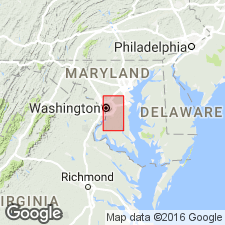
- Usage in publication:
-
- Chesapeake group*
- Modifications:
-
- Revised
- AAPG geologic province:
-
- Atlantic Coast basin
Summary:
In Prince Georges Co., MD, and in Washington, DC, Chesapeake group consists of (ascending) Calvert, Choptank, and St. Marys formations. Overlaps unconformably across Eocene Nanjemoy formation and Aquia greensand and Upper Cretaceous Monmouth formation on to Patapsco formation of Potomac group; overlain unconformably by Brandywine formation or by Pleistocene sand and gravel.
Source: GNU records (USGS DDS-6; Reston GNULEX).
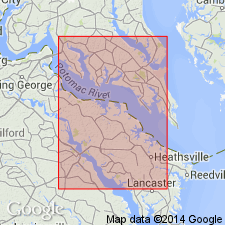
- Usage in publication:
-
- Chesapeake group*
- Modifications:
-
- Areal extent
- AAPG geologic province:
-
- Atlantic Coast basin
Summary:
Because Yorktown formation is extended from VA into MD, Chesapeake group in MD now contains same formations as in eastern VA (ascending): Calvert, Choptank, St. Marys, and Yorktown formations.
Source: GNU records (USGS DDS-6; Reston GNULEX).

- Usage in publication:
-
- Chesapeake Group*
- Modifications:
-
- Revised
- Age modified
- AAPG geologic province:
-
- Atlantic Coast basin
Summary:
Chesapeake Group revised to include Eastover Formation in MD and VA and its lower Claremont Manor Member and upper Cobham Bay Member (all new names) of late Miocene age. In NC, Chesapeake Group includes Eastover Formation and only its Cobham Bay Member. In addition, early Pliocene Yorktown Formation of Chesapeake Group in VA is divided into (ascending) Sunken Meadow, Rushmere, Morgarts Beach, and Moore House Members (all new); in NC, Yorktown includes all those members except Moore House. [GNU Note: Figure 2 of this report is a correlation chart that implies that Chesapeake Group also includes 1) early and middle Miocene Pungo River Formation and late Pliocene and early Pleistocene Croatan Formation in NC, 2) late Pliocene "Yadkin beds" in VA, and 3) middle Miocene "Little Cove Point" unit that occurs between Calvert and St. Marys Formations in MD. No mention is made of these units in report text. However, GNU records indicate that this publication was the first of the appropriate media to show these units and their relationship to Chesapeake Group. Implied age range of Chesapeake Group is therefore early Miocene to early Pleistocene.]
Source: GNU records (USGS DDS-6; Reston GNULEX).
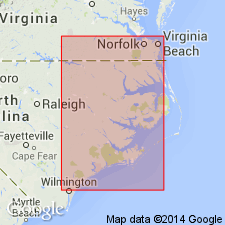
- Usage in publication:
-
- Chesapeake Group*
- Modifications:
-
- Revised
- AAPG geologic province:
-
- Atlantic Coast basin
Summary:
Chesapeake Group revised to include late Pliocene Chowan River Formation (new) (and its lower Edenhouse Member (new) and upper Colerain Beach Member (new)) and early Pleistocene James City Formation (named by DuBar and Solliday, 1963). Both formations constitute uppermost part of Chesapeake Group in northeastern NC and southeastern VA.
Source: GNU records (USGS DDS-6; Reston GNULEX).
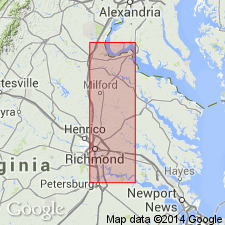
- Usage in publication:
-
- Chesapeake Group*
- Modifications:
-
- Revised
- Age modified
- AAPG geologic province:
-
- Atlantic Coast basin
Summary:
Old Church Formation of late Oligocene and early Miocene age named as basal formation of Chesapeake Group. Chesapeake Group now includes (ascending) Old Church Formation, Calvert Formation (and its Fairhaven Member, Plum Point Marl Member, and Calvert Beach Member), Choptank Formation (and its Drumcliff, St. Leonard, and Boston Cliffs Members), St. Marys Formation (and its Conoy Member and informal Little Cove Point and Windmill Point beds), Eastover Formation (and its Claremont Manor and Cobham Bay Members), Yorktown Formation (and its Sunken Meadow, Rushmere, Morgarts Beach, and Moore House Members), and Chowan River Formation (and its Edenhouse and Colerain Beach Members). Age range is revised as late Oligocene to late Pliocene. [No mention made of James City Formation which was included in Chesapeake Group by Blackwelder (1981).]
Source: GNU records (USGS DDS-6; Reston GNULEX).
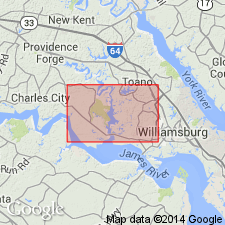
- Usage in publication:
-
- Chesapeake Group
- Modifications:
-
- Revised
- AAPG geologic province:
-
- Atlantic Coast basin
Summary:
Bacons Castle Formation assigned as uppermost unit to Chesapeake Group in this report. In Brandon and Norge quads of southeastern VA, outcrops of Chesapeake also include Yorktown and Eastover Formations. Units below the Eastover are known only from deep borings. Age is Miocene and Pliocene.
Source: GNU records (USGS DDS-6; Reston GNULEX).
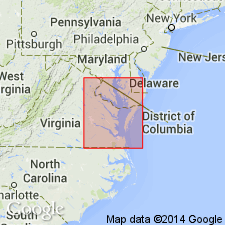
- Usage in publication:
-
- Chesapeake Group*
- Modifications:
-
- Revised
- Age modified
- AAPG geologic province:
-
- Atlantic Coast basin
Summary:
In Coastal Plain of VA, Chesapeake Group divided into: upper Pliocene Chowan River Formation, lower upper and lower Pliocene Yorktown Formation, upper Miocene Eastover Formation, upper and middle Miocene St. Marys Formation, middle Miocene Choptank Formation, and middle and lower Miocene Calvert Formation, restricting the age of the Chesapeake in this report to: lower Miocene to upper Pliocene. Upper Oligocene Old Church Formation is not included here in the Chesapeake but is mapped with other lower Tertiary deposits.
Source: GNU records (USGS DDS-6; Reston GNULEX).
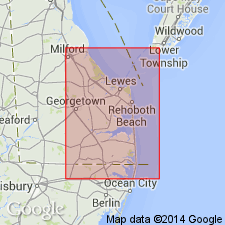
- Usage in publication:
-
- Chesapeake Group
- Modifications:
-
- Areal extent
- AAPG geologic province:
-
- Atlantic Coast basin
Summary:
Gamma-ray log signatures of the Calvert, Choptank, and St. Marys Formations of the Chesapeake Group in DE boreholes can be correlated with similar signatures on the log of the Miocene Kirkwood Formation in the Dickinson No. 1 of Cape May, NJ. However, the New Jersey Geological Survey does not recognize the Calvert, Choptank, and St. Marys Formations (P.J. Sugarman, pers. commun, 1990). Above the St. Marys, the NJ and DE sections differ. Author states, "My correlation of the gamma-ray log signatures of those formations in Delaware to Dickinson No. 1 does not imply that those formations exist in New Jersey."
Source: GNU records (USGS DDS-6; Reston GNULEX).
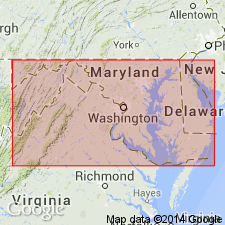
- Usage in publication:
-
- Chesapeake Group*
- Modifications:
-
- Overview
- AAPG geologic province:
-
- Atlantic Coast basin
Summary:
The following units constitute the Chesapeake Group: Old Church Formation (late Oligocene and early Miocene) in MD, VA, and DE?; Calvert Formation (early and middle Miocene) in DE, MD, and VA; Choptank Formation (middle Miocene) in DE, MD, and VA; St. Marys Formation (late Miocene) in MD and VA; Eastover Formation (late Miocene) in MD, VA, and NC; Yorktown Formation (early and late Pliocene) in VA and NC; and Chowan River Formation (late Pliocene) in VA and NC.
Source: GNU records (USGS DDS-6; Reston GNULEX).

- Usage in publication:
-
- Chesapeake Group
- Modifications:
-
- Overview
- AAPG geologic province:
-
- Atlantic Coast basin
Summary:
Chesapeake Group, though not divided on the State map, includes the following formations, which are described in the explanation: Chowan River, Yorktown, Eastover, St. Marys, Choptank, and Calvert. Group is described as fine- to coarse-grained, quartzose sand, silt and clay; variably shelly and diatomaceous, deposited mainly in shallow, inner- and middle-shelf waters. Age is early Miocene to late Pliocene.
Source: GNU records (USGS DDS-6; Reston GNULEX).
For more information, please contact Nancy Stamm, Geologic Names Committee Secretary.
Asterisk (*) indicates published by U.S. Geological Survey authors.
"No current usage" (†) implies that a name has been abandoned or has fallen into disuse. Former usage and, if known, replacement name given in parentheses ( ).
Slash (/) indicates name conflicts with nomenclatural guidelines (CSN, 1933; ACSN, 1961, 1970; NACSN, 1983, 2005, 2021). May be explained within brackets ([ ]).

